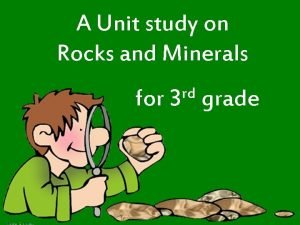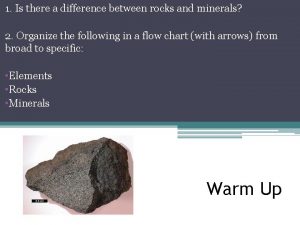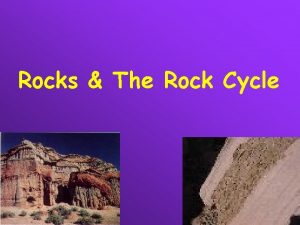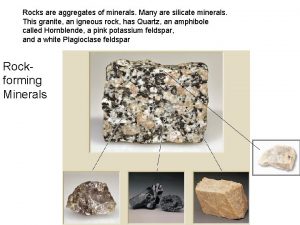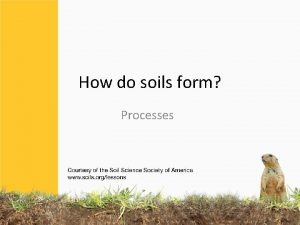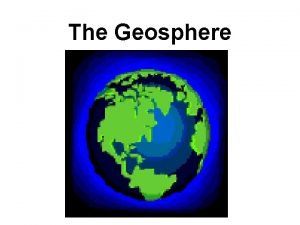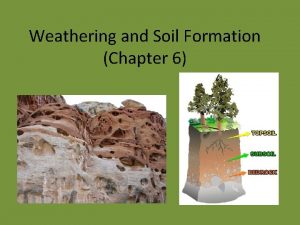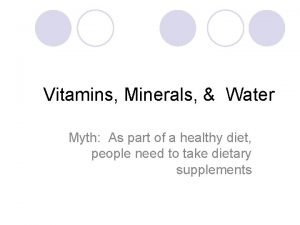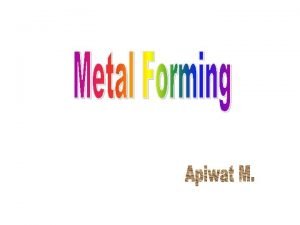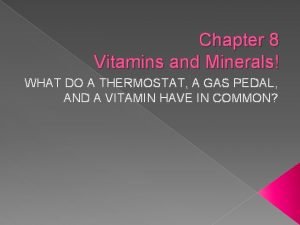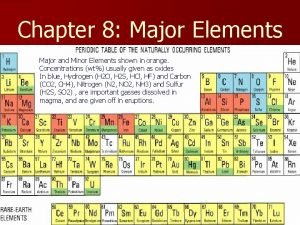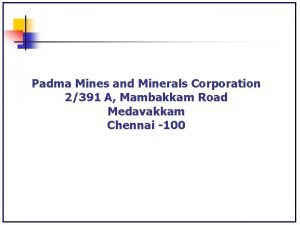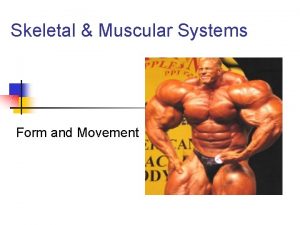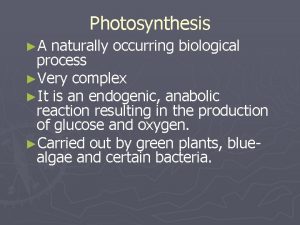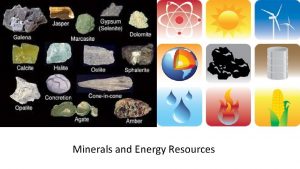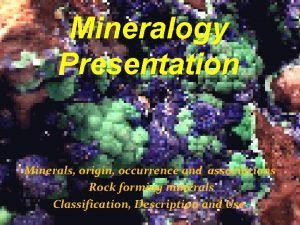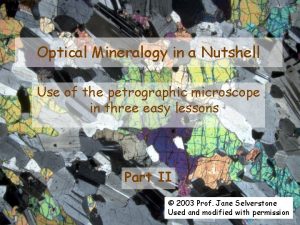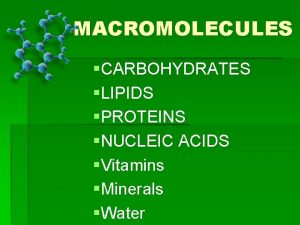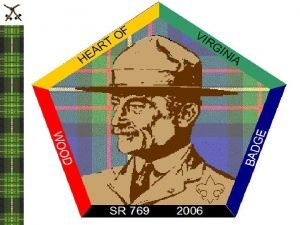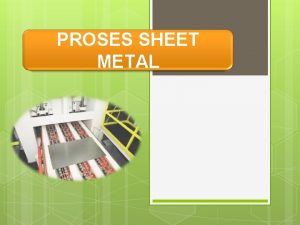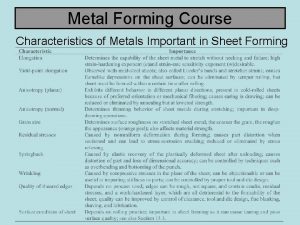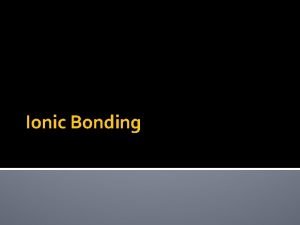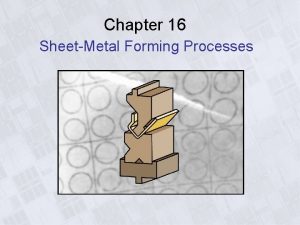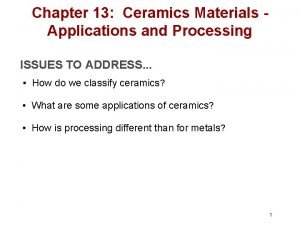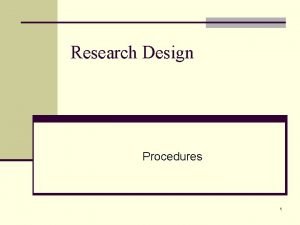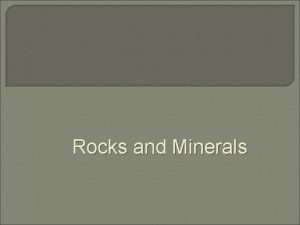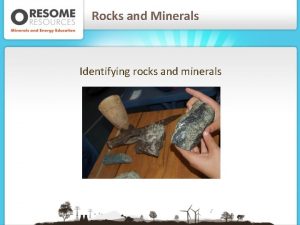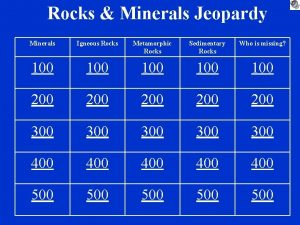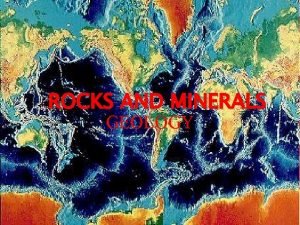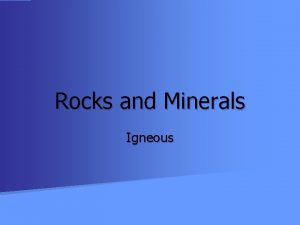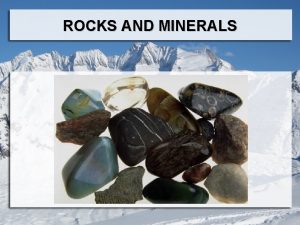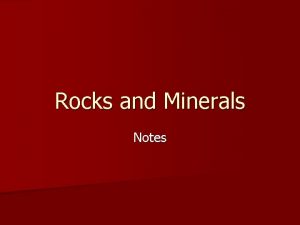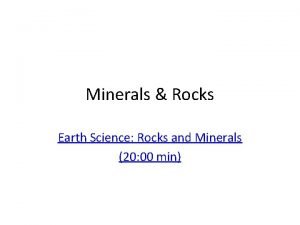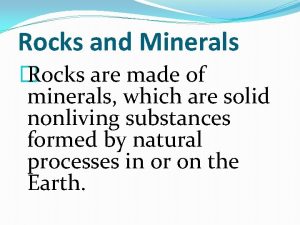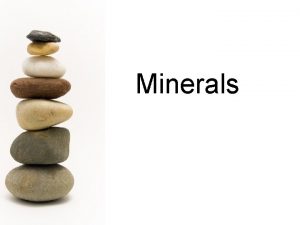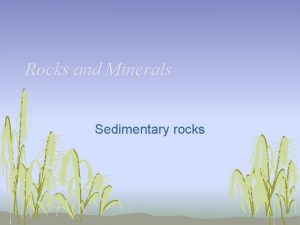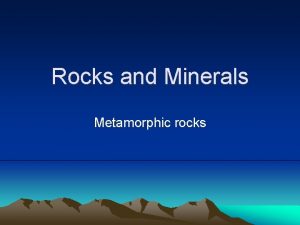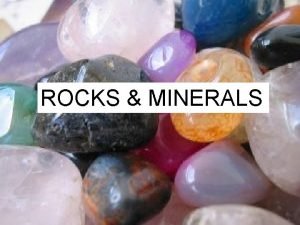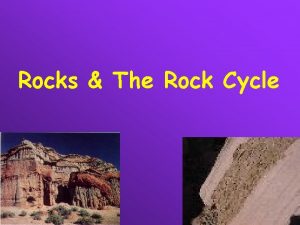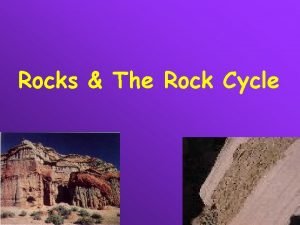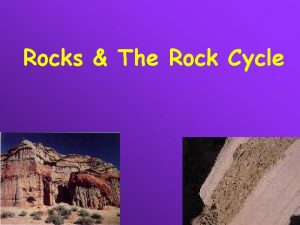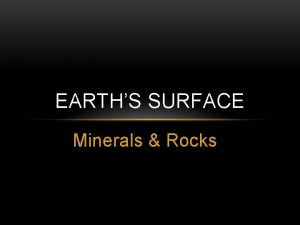Welcome Soil genesis Soil forming Rocks and minerals




















































- Slides: 52

Welcome Soil genesis: Soil forming Rocks and minerals. Date: 19 th February , 2020 Don Bosco College of Agriculture (Affiliated to Goa University) Don Bosco College of Agriculture

Sulphur Magnetite Copper Pyrite

Talc Graaphite Iron Pyrite

Mineral • A mineral is a naturally occurring homogeneous element or inorganic compound that has definite chemical composition and a characteristic geometric form. It usually consists of two-or more elements in chemical combination in certain definite proportion. • Inorganic Compound –Gypsum, Feldspar • Element– Iron , Copper , sulphur, Gold

Classification of minerals q. Classification based on • Mode of formation of minerals • Characteristic component of the rock • Specific Gravity • Chemical Composition

Classification based on Mode of formation of minerals • Primary Mineral– They are originated from original molten magma e. g. Feldspar, hornblende , mica , quartz • Secondary Mineral—Formed , deposited or introduced as a result of subsequent changes in rocks e. g. Limonite , gibbsite

Classification based on Characteristic Component of rock • Essential Mineral—Minerals which form the chief constituent of rock and are regarded as characteristic component of that rock e. g. Feldspar, pyroxenes, mica • Accessory Mineral—Minerals which occur only in small quantity and whose presence or absence is of no consequences as far as the character of rock is concerned e. g. Tourmaline , Magnetite

Classification based on Specific Gravity • Heavy Mineral—The minerals having specific gravity more than 2. 85 g/cc e. g. Quartz(2. 6), Feldspar(2. 65) • Light Mineral—The minerals having specific gravity less than 2. 85 g/cc e. g. Haematite (503) , Pyrite(5. 0) , Limonite(3. 8)

Classification Based on Chemical Composition • Native Elements –Graphite , Sulphur , Gold , Copper • Oxides and Hydroxides—Quartz Si. O 2, Haematite Fe 2 O 3 , Gibbsite Al(OH)3 • Sulphates– Gypsum Ca. SO 4. 2 H 2 O • Sulphides—Pyrite Fe. S 2 • Carbonates—Calcite Ca. Co 3 • Halides---Rock Salt Nacl • Silicates--- Orthoclase KAl. Si 3 O 8, Olivine Mg. Fe. Si. O 4

General Properties of Mineral ) Color 2) Luster 3) Light transmission 4) Hardness 5) Streak 6) Specific gravity 7) Form and structure 8) Cleavage 9) Fracture 10) Tenacity 11) Chemical nature 1

Color • The color of mineral depends on reflection of certain color vibrations which are exhibited by ordinary light. Ordinary light contains number of color vibrations like Red, Pink, Yellow, Green White and Purple and these colors are absorbed by minerals, reflecting one of them, give color to the minerals. Mineral may be colorless, white, yellow, pink purple, green etc : e. g. 1) Calcite — White 2) Orthoclase — Pink 3) Apophylite — Green 4) Quartz — Colorless 5) Magnetite — Black 6) Iron pyrite - Yellow 7) Amethyst - Purple

Luster It is the appearance shown by each mineral e. g. shining of the mineral or the manner in which a substance reflects light. There are two types of luster. a) Metallic luster, it is the luster resembling luster of metal e. g. Iron Pyrite. b) Non-Metallic Luster. i) Adamantine luster It is the luster resembling the luster of Diamond ii) Vitreous luster: Luster like ordinary glass e. g. Rock crystal. iii) Sub-Vitreous luster Luster-like milky glass e. g. Milk quartz. iv) Resinous luster Luster like resin e. g. Talc. v) Pearly luster Luster like pearl e. g. Zeolite. vi) Earthy luster. Luster like earth e. g. Gypsum. vii) Waxy luster Luster fike wax e. g. Apatite. vii ) Silky luster Luster like silk e. g. Asbestos.

Light transmission It is the property of mineral to judge whether a mineral is transparent, translucent or opaque. i) Transparent : When the out line of the object appears distinct and clear through a mineral, it is called transparent e. g. -Rock crystal, Muscovite Mica, Calcite and Biotite. Ii)Translucent : When the outline-of the object does not appear clear and distinct but it is indistinct then it is called translucent e. g. Milk quartz. iii) Opaque : . When no light passes through a mineral, it is called opaque e. g. Magnetite, Iron Pyrite, Copper Pyrite.

Hardness • It is the resistance offered by a mineral to a scratching. Mohr has found a scale of hardness to determine the hardness of different minerals. • This is called as Mohr's scale of hardness. Relative hardness of some minerals in increasing order to hardness is given below 1) Talc (Softest) 2) Gypsum 3) Calcite 4) Fluorite 5) Apatite 6)Feldspar 7) Quartz 8) topaz 9) Corundum 10) Diamond (hardest) Roughly the hardness of finger nail is = 2 Copper wire = 3 Glass piece = 5. 5 and Sharp steel = 6. 5

Streak It is the color of the powder of a mineral. it may be different from the color of mineral Generally white minerals have got white streak e. g. Sr. No. Name of Mineral Color of Mineral. 1. Rock crystal White 2. Orthoclase Pink 3. Iron Pyrite Yellow 4. Magnetite Black 5. Hematite Black Streak White Green. Black Cherry Red

Specific gravity It is the ratio of weight of mineral to the weight of equal volume of water.

Forms ) Forms : Minera. Is have got various forms. When a definite form is developed, it is called crystalline from and when no form is developed. It is called massive or amorphous form. The Forms are : 1) Massive or amorphous 2) Crystalline A

Structure : The arrangement of crystals give rise to several kinds of structures. 1) 2) 3) 4) 5) 6) Granular : When in fine- check grains. Lamellar : Like plates or leaves. Columnar or Fibrous : Needle like Reticulated or net like. Stellated when radiating like a star Drusy when minute crystals implanted.

Cleavage • It is the tendency of some minerals to split along planes related to the molecular structure, sometimes parallel to crystal faces and yielding more or less smooth surfaces. • Cleavage may be perfect or imperfect. Perfect e. g. Diamond

Fracture Not all minerals show good cleavage. Most show fracture or breakages in directions other than cleavage planes. The fracture may be even, Uneven, earthy (as in clay) and conchoidal. i) Conchoidal : Development of more or less curved surface: ii) Uneven : Development of rough surface and iii) Even : Development of smooth and plane surfaces.

Tenacity Mineral may be i) Brittle-- when it falls to powder at the time of cuttings ii) Flexible-- when it can be easily bent iii) Malleable -- if its pieces flatten under a hammer

Chemical nature • Native Elements –Graphite , Sulphur , Gold , Copper • Oxides and Hydroxides—Quartz Si. O 2, Haematite Fe 2 O 3 , Gibbsite Al(OH)3 • Sulphates– Gypsum Ca. SO 4. 2 H 2 O • Sulphides—Pyrite Fe. S 2 • Carbonates—Calcite Ca. Co 3 • Halides---Rock Salt Nacl • Silicates--- Orthoclase KAl. Si 3 O 8, Olivine Mg. Fe. Si. O 4

Rock----Petrology—Study of Rocks • Definition of Rock • A rock may be defined as an aggregate of one or more minerals. For example an aggregate of the single mineral calcite is the Limestone rock, while the granite rock is composed of several minerals, like orthoclase, mica, quartz-with or without hornblende.


Classification of Rocks Igneous Rocks Sedimentary Rocks Metamorphic Rocks 1. Plutonic Dykes, Sills , Veins 1. Arnaceous 1. Dynamo metamorphic 2. Volcanic Vesicular 2. Argillaceous 2. Thermo metamorphic 3. Calcareous 3. Hydro metamorphic 4. Carbonaceous 5. Siliceous 6. Precipitated

I). Igneous Rocks( Ignis — Fire hence Fire rocks) Igneous rocks are those rocks, which have been formed by the action of heat. These rocks were the first to be formed when the molten mass cooled and consolidated into solid rock. These rocks are massive and crystalline. They constitute nearly 95% of the earth's crust and about 16 km thick. They are first to form in nature hence they are called as Oldest rocks. Heat is the major agency in their formation hence they are called as Fire Rocks. They mostly consist 'of primary minerals like quartz, micas, feldspar, pyroxenes etc: Igneous rocks are grouped into two groups : 1) 2) Intrusive or plutonic rocks Extrusive or volcanic rocks

1) Intrusive or Plutonic rocks : The igneous rocks which are formed by the cooling of the original magma beneath the surface are called intrusive rock e. g. Granite. They occur at greater depth in the earths crust. They are very compact. Intrusive rocks were formed as a result of the molten mass having been formed among the pre-existing solid rocks through the cracks and other planes of weakness. Some of these rocks consolidated in vertical cracks and formed wall like masses, called dykes. Other that consolidated in horizontal cracks or planes are known as sills and those are formed as irregular cracks called veins. They are formed due to slow cooing hence they are coarse crystalline rocks.

Dykes Sills Veins

Dykes Sills Veins

Dyke

Dyke

2)Extrusive or Volcanic Rock Extrusive rocks are those that were formed when the molten mass was poured out on the surface of the earth where it is consolidated on cooling. They contain many gas cavities. The rocks , which contain gas cavities or vesicles are known as vesicular rocks. Some minerals may embedded these cavities. Hence such rocks are known as amygdaloidal rocks. The minerals so embedded are quartz, calcite, Zeolite , Glauconite. They are formed due to rapid cooling , hence they are fine crystalline rocks.

vesicular Rock

Vesiculaar Rock

Amygdaloidal Rock

Amygdaloidal Rock

Sedimentary rock (Aqueous, stratified rocks) Process of Formation 1. Weathering 2. Transportation 3. Deposition or Sedimentation 4. Digenesis ( Compaction , Cementation )

Sedimentary rock (Aqueous, stratified rocks) 1. Igneous rocks when exposed to the action of, atmosphere, break up into loose masses of crushed, crumbled and mellowed material tailed sediments. 2. These sediments are carried away by flowing water into lakes and seas. 3. Further they are deposited as sediments in lakes and seas. 4. The Digenesis : The dissolved material from the rocks are also deposited when the water evaporates. These deposits remain as loose material or cemented. consolidated into sedimentary rocks. The cementing material used for compacting the loose materials are silica or lime or oxides of iron. In such a way compact rocks are formed from loose sediments. Sedimentary rocks are also called stratified rocks. They are also called aqueous rocks as water is the chief agency in their formation and stratified rocks as the sediments are usually deposited in layers or starts.

Sedimentary rocks are classified as 1) Arnaceous or sandy rocks : These rocks mainly consists of coarse particles usually known as Quartz and Feldspar e. g. Sandstone, grit, Conglomerate, Breccias. 2)- Argillaceous rocks : Consist of small size particles usually known as clay e. p. Clay, Mudstone, Shale. 3) Calcareous rocks : Usually consists of calcium carbonate and magnesium carbonate e. g. limestone, chalk, dolomite, etc.

4) Carbonaceous rocks : Formed from decomposing vegetation under anaerobic conditions e. g. coal, peat, lignite. 5) Siliceous rocks : They are of organic origin having been formed from parts of minute plants and animals and deposited either from salts or fresh water. e. g. Diatomaceous earth. 6) Precipitated rocks : They are mainly deposits, formed as rock masses either by cooling, evaporation or by direct chemical precipitation e. g. Gypsum, rock sale:

Sandstone

Limestone

Mudstone

Diatomaceous Rock

Coal Gypssum

Metamorphic rocks: • Igneous and sedimentary rocks undergo a change. When the change is considerable, the rock is said to have undergone metamorphosis and the new rock is known as a metamorphic rock. • The metamorphosis is brought about by the action of water, heat or pressure.

Hydro metamorphic rocks • The change in igneous and sedimentary rocks brought about by water is known as hydro metamorphism • The rocks so formed are known as hydro metamorphic Rocks e. g. Basalt and granite converted into laterite.

Basalt to laterite Basalt laterite

Thermo-metamorphic rock • The change in rocks brought about by heat is known as Themometamorphism and the rocks so formed are known as thermometamorphic Rocks • Thermometamorphism may be caused by volcanic lava and the heat can fuse or _ melt the original rocks e. g. Sandstone is converted into quartzite and limestone is converted into marble.

Limestone to Marble Limestone Marble

Dynamo metamorphic rocks • Dynamo metamorphism is due to pressure brought about by the folding of rocks due to crust movement of the earth. As a result of this pressure, the crystals in rocks are flattened and they are called as folia e. g. thick in the middle and thin at edges. Such rocks are called foliated rock. When the foliation is slight and the folia are not separate, . The rock is called the gneiss. e. g. Gneiss , Granite gneiss, Diorite gneiss. • If the crystals are very much flattened and the folia are easily separated, then the rock is called schist Schist : Mica schist, Quartz Schist, Chlorite schist, Talc schist.

Shale to Slate Shale Slate
 Types of igneous sedimentary and metamorphic rocks
Types of igneous sedimentary and metamorphic rocks Igneous rocks metamorphic rocks and sedimentary rocks
Igneous rocks metamorphic rocks and sedimentary rocks What type of rock is this
What type of rock is this Granite and basalt difference
Granite and basalt difference Difference between minerals and rocks
Difference between minerals and rocks Igneous rock
Igneous rock Poem about minerals and rocks 3 stanza
Poem about minerals and rocks 3 stanza Difference between rocks and stones
Difference between rocks and stones Rocks and minerals
Rocks and minerals Quartzite rock cycle
Quartzite rock cycle Rocks are aggregates of minerals
Rocks are aggregates of minerals Extrusive rocks
Extrusive rocks Site:slidetodoc.com
Site:slidetodoc.com 4 soil forming processes
4 soil forming processes Minerals in the soil
Minerals in the soil Types of weathering
Types of weathering Living soil vs dead soil
Living soil vs dead soil Four major spheres of the earth
Four major spheres of the earth Welcome welcome this is our christmas story
Welcome welcome this is our christmas story Minerals and their functions sources and deficiency chart
Minerals and their functions sources and deficiency chart Mcq on sheet metal forming
Mcq on sheet metal forming Forming and solving equations
Forming and solving equations Forming and solving linear equations worksheet
Forming and solving linear equations worksheet Hot working vs cold working
Hot working vs cold working Vacuum forming companies near me
Vacuum forming companies near me Comparative and superlative
Comparative and superlative Sheet metal fundamentals
Sheet metal fundamentals Forming and solving equations worksheet
Forming and solving equations worksheet Chapter 8 vitamins and minerals
Chapter 8 vitamins and minerals Minor elements
Minor elements Absorbs water and minerals
Absorbs water and minerals Padma mines and minerals corporation
Padma mines and minerals corporation Stores minerals and anchors muscles
Stores minerals and anchors muscles Cumbria minerals and waste local plan
Cumbria minerals and waste local plan Resource that can be replaced
Resource that can be replaced Minerals and fuels
Minerals and fuels Vitamins sources functions and deficiency chart
Vitamins sources functions and deficiency chart Minerals and fuels
Minerals and fuels Classification of minerals
Classification of minerals Ntd nutrition
Ntd nutrition Biaxial indicatrix
Biaxial indicatrix Are vitamins and minerals macromolecules
Are vitamins and minerals macromolecules Perfoming stage
Perfoming stage Storming norming conforming performing
Storming norming conforming performing Sheet metal working adalah
Sheet metal working adalah Corynebacterium diphtheriae spore forming
Corynebacterium diphtheriae spore forming Draw bead
Draw bead Unit chemical bonding forming ionic compounds ws 2
Unit chemical bonding forming ionic compounds ws 2 Synthesizing information allows a reader to
Synthesizing information allows a reader to Forming process in sheet metal
Forming process in sheet metal Particulate forming ceramics
Particulate forming ceramics Organs forming the respiratory passageway
Organs forming the respiratory passageway Forming research design
Forming research design




